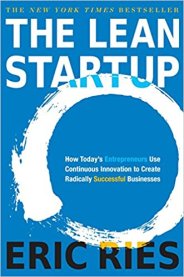Though I have spent most of my career in marketing, I finally took my first real marketing class in the spring 2018 semester of my MBA. 30 of us paid a collective $60,000 to learn the 4 P’s, market research techniques, how to write a business plan, and a dozen other interesting concepts.

I enjoyed the class, but thought it was a little dated. Aside from a brief chapter on eMarketing, it was unchanged from what MBA students learned 30 years ago. It may be true that marketing principles are immutable and timeless, like Euclidean geometry or symbolic logic, but probably the class just needed to be refreshed.
It so happened that while I was spending my evenings learning very traditional marketing techniques, I was also reading The Lean Start Up – a completely non-traditional marketing book. The conflict between the two techniques was interesting.
The problem with traditional marketing and product development
A traditional marketing approach begins with a plan. A marketer researches demographics and psychographics, segments and targets the market, and designs positioning (STP). These details are encapsulated in a marketing plan which rolls up into a larger business plan. Once this is complete, all that is left to do is hydrate the plan with money from investors and schedule the IPO.
The Lean Start Up disagrees. It says that the assumptions built into formal, traditional business and marketing plans are (1) hugely consequential, and (2) likely wrong. Without testing and refining these assumptions in a scientific way, the company will waste time and money developing products no one wants.
In an example from the book, a traditional marketing plan is analogous to a space shuttle’s flight plan. Every detail from 3 hours before launch to the slight adjustments on exiting the atmosphere are scheduled. The structure ensures execution but prevents adjustment.
The Lean Startup approach is more like planning a cross country drive. You know where you’re going, but where you stop for gas, when you pass the semi, and even the highway you take is decided en route. It relies on the ingenuity of the team to overcome and adjust along the way.
The Lean Startup Model
A Lean Startup method validates assumptions by developing a series of experiments. The results of these experiments reveals which features customers want, how they prefer to consume those features, the price they are willing to pay, and the business model that supports that product.
Zappos, for example, needed to validate the assumption that customers would buy shoes online. Under the Lean Startup model, this assumption became a verifiable hypothesis, which they tested by photographing shoes in a shoe store with the promise to the shoe store owner that if someone bought the shoes on their website, they would return and buy them from him at full price to send to the customer. It was a zero cost, zero profit experiment that validated their most important assumption.
Under a traditional marketing / business plan approach, Zappos would have rented a warehouse, stocked it, built the website, hired employees, chosen a 401k plan, joined the chamber of commerce, etc. before they sold a single pair of shoes. If the assumption (hypothesis) that people would buy shoes online were proven untrue, their initial investment would be a waste.
The Lean Startup and my MBA
For the final project of my marketing class, we developed a marketing plan for a new product and presented it to the class. I was impressed by how well these plans came together. My own group developed a plan for selling women’s fly fishing wader pants, and we came in second in the voting.
But, in retrospect, each project was based on a series of untested assumptions about customer demand and the practicality of the idea. We’d segmented our market, targeted what we thought was a profitable demographic, and positioned out product the way we thought it would appeal to our buyers, but none of us proved:
- Our segmentation matched how buyers buy;
- We were targeting the right segment (least competitive and most profitable);
- We were positioning our product to our chosen segment properly;
- Our buyers recognized they had this need;
- Our buyers would spend to solve it; and,
- We could profitably sell at the right price point, etc.
I’m taking away from the class and the book that research and intentionality in forming a business is critical, but more importantly assumptions must be confirmed.
Steven,
Great thoughts. I tend to agree with you in all of your outlined points. Where I believe people struggle with the lean startup approach (or User Testing or Design Thinking approach to problem solving, pick your flavor) is the inherent lack of a plan to follow or “proven formula.” People tend to avoid uncertainty and lean on their preconceived notions or personal experiences to explain the world; we see those psychological tendencies show themselves more in marketing than in almost any other space I’ve worked in. Further, this approach requires marketers to get closer to their markets/understand their users, emphasizes the use of statistical or behavioral data to drive decisions, and ultimately requires a complete redesign of the marketing approach to problem solving. A tall order to say the least.
You and I have had conversations on the difficulty of getting established businesses to follow lean and startup philosophies – it’s an uphill battle on the best of days.
Thoughts?
/J